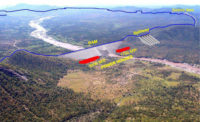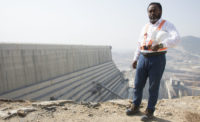
Investigating safety concerns posed by the $4.8-billion Grand Renaissance Dam in Ethiopia, a joint committee comprising representatives from Egypt, Ethiopia and Sudan, among others, recently made its last trip to the hydropower-plant site before compiling its report.
Formed in June, the Nile Tripartite Committee, which has two members from each country and four international dam experts, visited the project site in October and is expected to submit a report on its findings to the three governments in February 2013.
The investigations were prompted by Egypt’s opposition to the 5,250-MW hydropower plant on the Blue Nile, the main source of the River Nile. Egypt gets 85% of its total water supply from the Nile.
Earlier, Ethiopia rejected a request by Egypt for the publication of the project’s environmental impact assessment study. The study has never been made public. Ethiopa also rejected Egypt's request for the plant's design details.
Six countries that share the Nile River with Egypt, Ethiopia and Sudan proposed the investigation after Egyptian officials and other experts expressed fears over the long-term sustainability of the project, which broke ground in April 2011.
The project involves the construction of a gravity-type dam with a roller-compacted concrete core measuring 145 meters high and 1,800 m long.
The hydro project features two powerhouses on either side of the spillway. The right-side powerhouse features ten 350-MW Francis turbine generators, while the left-side plant sports five.
With an area more than twice the size of Singapore, the 1,680-sq-kilometer reservoir has a 65-billion-cu-m capacity. Ethiopia is funding the project through government bonds, and Chinese banks will underwrite the turbine acquisition.
The dam and reservoir are both supported by a 5-km-long, 50-m-high saddle dam.
Egypt has called the construction of the hydropower plant “a national security threat” because, upon completion in 2018, it would reduce the country's share of the Nile's available flow by as much as 25%.
Experts have questioned the viability of the massive dam, which has a plant load factor of 33%. For example, non-governmental organization International Rivers says that other, smaller dams in Africa have higher efficiencies, with load factors of 45% to 60%.
Some residents of the downstream communities, who for centuries have farmed in the floodplain each year after the spring floods, say damming the Blue Nile would deny them water for farming.
Further concerns have been raised over the impact on the Blue Nile of the reservoir's high annual evaporative losses, estimated at 3 billion cu m.
Meles Zenawi, the former Ethiopian prime minister who died in August, claimed evaporation would be reduced because the reservoir is deep and elevated.
In February, an engineer at the project site told International Rivers that, when the project started, there had been no conclusive study on the rock formations that will support the dam, raising fears the formations are unsuitable.
Discussions also have broached the project's long-term sustainability, with projections indicating that global warming could substantially alter the region’s hydrological cycles.
Noting the secrecy surrounding the design details of the Grand Renaissance and 15 other dams Ethiopa wants to build, critics have pointed out that the landlocked country's complex geology already has caused accidents.
Two years ago on the Omo River, a 26-km-long raceway tunnel at the $600-million Gibe II power station collapsed only 10 days after it was inaugurated. Repairs took nearly a year.



Post a comment to this article
Report Abusive Comment